非线性薛定谔方程求解
- 格式:pdf
- 大小:121.04 KB
- 文档页数:24
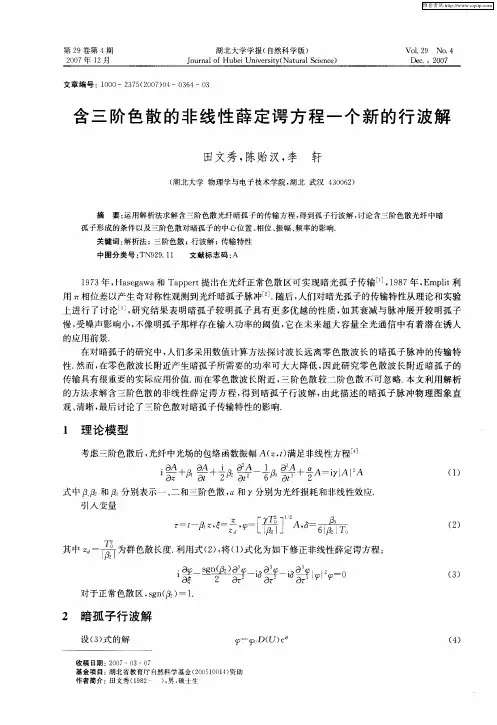
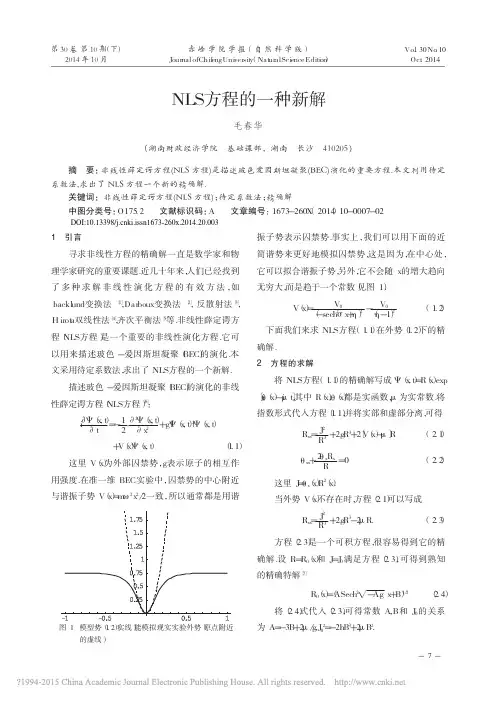
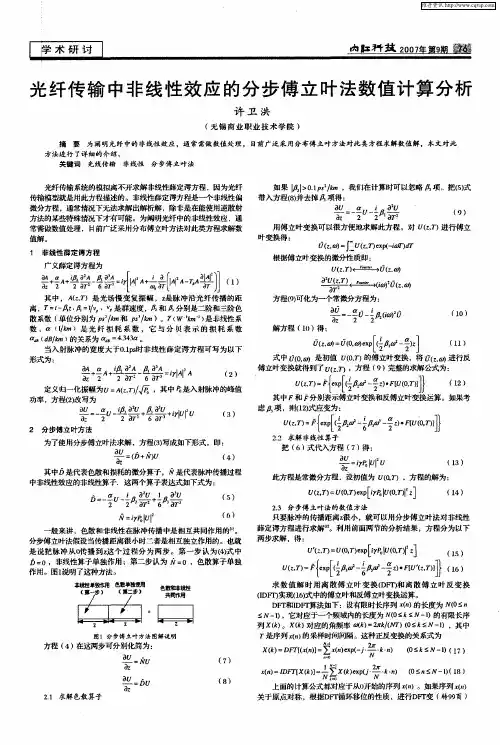
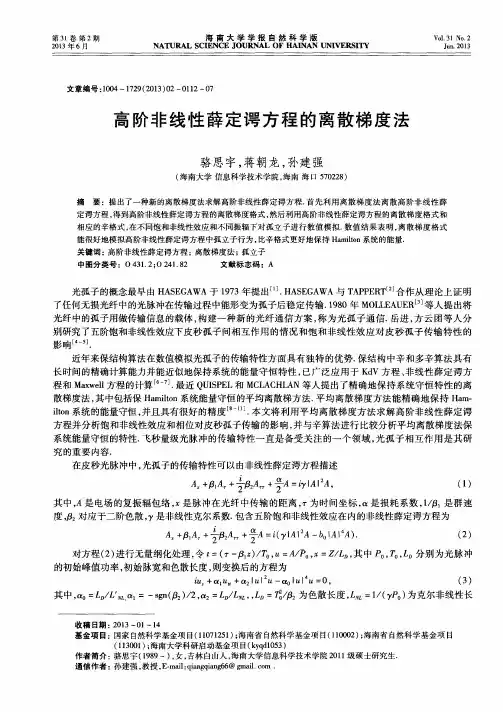
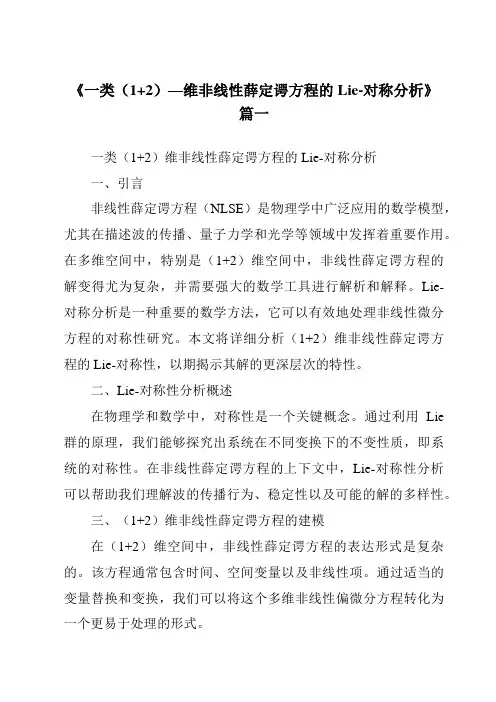
《一类(1+2)—维非线性薛定谔方程的Lie-对称分析》篇一一类(1+2)维非线性薛定谔方程的Lie-对称分析一、引言非线性薛定谔方程(NLSE)是物理学中广泛应用的数学模型,尤其在描述波的传播、量子力学和光学等领域中发挥着重要作用。
在多维空间中,特别是(1+2)维空间中,非线性薛定谔方程的解变得尤为复杂,并需要强大的数学工具进行解析和解释。
Lie-对称分析是一种重要的数学方法,它可以有效地处理非线性微分方程的对称性研究。
本文将详细分析(1+2)维非线性薛定谔方程的Lie-对称性,以期揭示其解的更深层次的特性。
二、Lie-对称性分析概述在物理学和数学中,对称性是一个关键概念。
通过利用Lie 群的原理,我们能够探究出系统在不同变换下的不变性质,即系统的对称性。
在非线性薛定谔方程的上下文中,Lie-对称性分析可以帮助我们理解波的传播行为、稳定性以及可能的解的多样性。
三、(1+2)维非线性薛定谔方程的建模在(1+2)维空间中,非线性薛定谔方程的表达形式是复杂的。
该方程通常包含时间、空间变量以及非线性项。
通过适当的变量替换和变换,我们可以将这个多维非线性偏微分方程转化为一个更易于处理的形式。
四、Lie-对称性的应用Lie-对称性分析可以应用于(1+2)维非线性薛定谔方程的多个方面。
首先,我们可以利用Lie群理论来寻找该方程的对称变换,这些变换可能揭示出方程解的某种不变性质。
其次,通过分析这些对称变换的性质,我们可以进一步了解波的传播行为和稳定性。
此外,Lie-对称性分析还可以帮助我们找到新的解或解集,从而扩展我们对该方程的理解。
五、分析结果与讨论通过Lie-对称性分析,(1+2)维非线性薛定谔方程的某些对称变换被揭示出来。
这些对称变换有助于我们理解该方程的解的某些不变性质。
此外,我们还发现了一些新的解或解集,这进一步扩展了我们对该方程的理解。
然而,需要注意的是,Lie-对称性分析是一个复杂的过程,可能涉及到许多高阶偏微分方程的求解问题。

湖南师范大学硕士学位论文非线性薛定谔方程的孤子微扰理论及应用姓名:俞慧友申请学位级别:硕士专业:理论物理指导教师:颜家壬20050301摘要孤子理论是非线性科学中的一个十分重要的分支,它在物理学的许多领域中有着日益广泛的应用。
而孤子的微扰又是孤子理论中最有实用价值的重要内容之一.它大体可以分为两大类.一是建立在逆散射变换基础上的孤子微扰理论。
它在理论上有着重要的学术价值,但其思路较迂回曲折,数学计算较繁.另一种直接微扰论较为系统的方法是将孤子方程线性化后再按Jost函数的平方作微扰展开。
这两种方法均只适用于可积系统。
颜家壬教授近年来发展了一种基于分离变量法的孤子微扰理论法,它适用于可积和非可积系统,而且思路和计算较为简便.本人首先用此方法处理了自散焦非线性薛定谔方程的孤子微扰问题.一方面是由于问题的重要性,另一方面也是为丰富颜教授所发展的孤子微扰理论的内容,为它提供一个重要的实例.其次我们还用此方法处理了玻色一爱因斯坦凝聚中的亮孤子稳定性问题.全文共分为五章t第一章简要介绍孤子的发展史以及孤子微扰问题的几种常用的方法,并指出这些方法存在的~些缺点,同时也叙述了我们方法的大致思路和主要特征.第二章给出了关于非线性薛定谔方程的微扰理论,并通过具体工作来说明我们的基于直接微扰理论的两种不同的思路方法.第三章简单的介绍和回顾BEC理论的产生发展及实验研究过程,推导出了凝聚体宏观波函数满足的GP方程.然后讨论了BEC中暗孤子和亮孤子的实验情况和理论研究现状.第四章本人基于直接微扰理论研究了BEC中亮孤子的稳定性问题。
第五章为总结和展望.关键词:非线性薛定谔方程,孤子,微扰,玻色一爱因斯坦凝聚ABSTRACTSolitontheoryiSoneoftheimportantbranchesofnOnlinearscieneeIthascrescentapplicationinmanyfields.Tilesoftenperturbationproblemisanimportantpartofthesolitontheory.Itexistsinalargenumberofrealnonlinearsystemsandcallberoughlydividedtotwokinds.Oneisbasedontheinversescatteringtransformation(IST)whichhasimportantlearningvalue.ButthistechniqueiSinconvenienttothosewhoarenotfamiliarwithIST.AnotheristhedirectmethodwherethesquaredJestsolutions&reemployedasthebasisforperturbationexpansionaftersolitoneqationbeenlineared.Theyarejustapplicabletointegralsystems.ProfessorJiarenYan,whoismythesissupervisor,haddevelopedadirectapproachoftheperturbationthoerybasedonseparatingvariabletechnique,whichisapplicabletobothintegrableandunintegralsystems.Itismoresimpleandconvenientinmethodandcalculation.ItackletheperturbationproblemofthenonlinearSchrhdingcrequationbecauseofitsimportance.Atthesan2ctime,itenrichedthesolitonperturbationthoeryofProfessorYauandofferedimportantexamples.Next,IstudiedthestabilityofbrightsolitonsinBose-Einsteincondensatebasedonthcdirectapproach.Thisthesisconsistsoffivechapters.Thefirstchapterhastwoparts.Firstjwebrieflyintroducethedevelopmenthistoryofthesolitonanddiscusssomegeneralapproachestodealwiththesolitonperturbationproblems,andpointoutsomedrawbacksoftheseapproaches.Secondly,wepresentthegeneralpro-cedureofourapproachanditsmajorcharacteristics.Inthesecondchapter,weestablishtheperturbationtheoryforthenonlinearSchrhdingerequation,andstudyitsspecificperturbation.Wewillexplainthetwodifferentapproaches,whicharebasedonthedirectapproachthroughtheworkthatwehavedone.InthethirdchapterwebrieflyintroducetheformationanddevelopmentofBose-Einsteincondensation’stheoryandit’Sexperiments.ThenwederivethenonlinearGross.Pitaevaskiiequationthatsatisfiesthecondensatemacroscopicwavefunction.Attheendofthischapter,wediscussthetheoreticalstudiesandexperimentsgdarksolitonsandhi痨tsolJtons啦转锱争冀i魏髓e啦c。
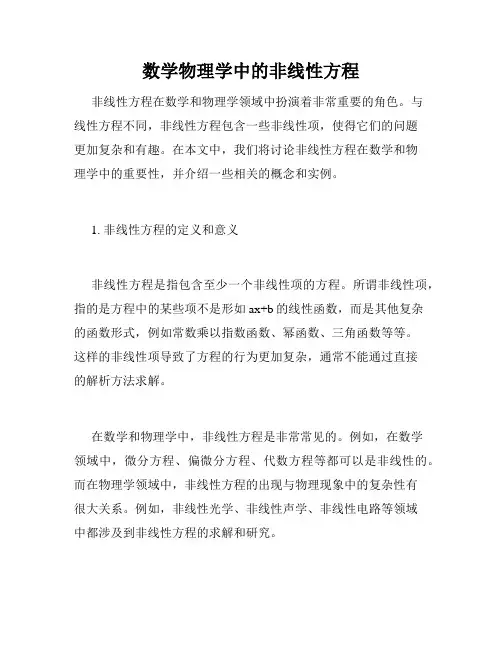
数学物理学中的非线性方程非线性方程在数学和物理学领域中扮演着非常重要的角色。
与线性方程不同,非线性方程包含一些非线性项,使得它们的问题更加复杂和有趣。
在本文中,我们将讨论非线性方程在数学和物理学中的重要性,并介绍一些相关的概念和实例。
1. 非线性方程的定义和意义非线性方程是指包含至少一个非线性项的方程。
所谓非线性项,指的是方程中的某些项不是形如ax+b的线性函数,而是其他复杂的函数形式,例如常数乘以指数函数、幂函数、三角函数等等。
这样的非线性项导致了方程的行为更加复杂,通常不能通过直接的解析方法求解。
在数学和物理学中,非线性方程是非常常见的。
例如,在数学领域中,微分方程、偏微分方程、代数方程等都可以是非线性的。
而在物理学领域中,非线性方程的出现与物理现象中的复杂性有很大关系。
例如,非线性光学、非线性声学、非线性电路等领域中都涉及到非线性方程的求解和研究。
2. 非线性方程的求解方法由于非线性方程的复杂性,通常不能通过类似于解线性方程的代数方法来解决。
但是,有一些常见的方法和技巧可以用来求解非线性方程。
下面简单介绍几种常见的方法。
(1)牛顿迭代法牛顿迭代法是一种求解非线性方程的常用方法。
它的基本思想是在每一步迭代中,将当前点的切线与x轴相交得到一个新的估计值,并不断重复此操作直到收敛。
(2)取初值法非线性方程的求解通常需要使用迭代方法,而迭代方法的收敛性与初值的选择密切相关。
有时候,通过选择合适的初值可以提高迭代算法的收敛性和速度。
(3)变量代换法变量代换法是一种求解非线性方程的常见方法。
通过合适的变量代换,可以将原来的非线性方程转化为一些更加易于求解的形式。
例如,在求解三角方程时,通常采用换元sinx=t或cosx=t,将三角函数转化为代数函数,进而求解方程。
3. 非线性方程的实例下面简单介绍一些非线性方程的实例,包括微分方程、偏微分方程和代数方程等。
(1)非线性微分方程非线性微分方程在数学和物理学中都有广泛的应用。
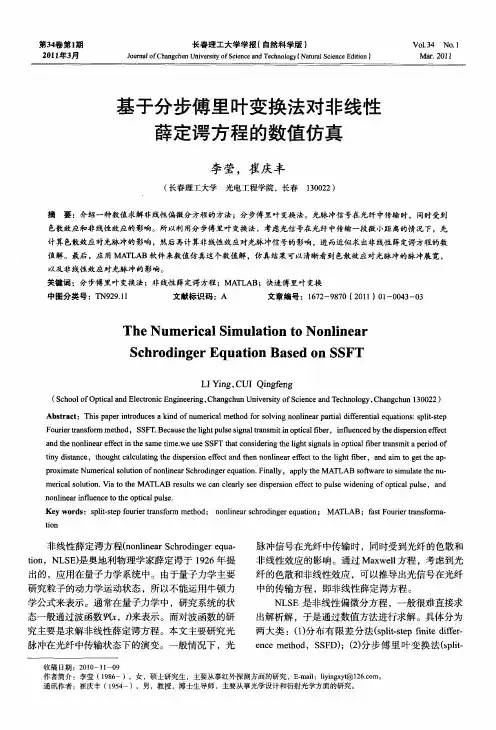
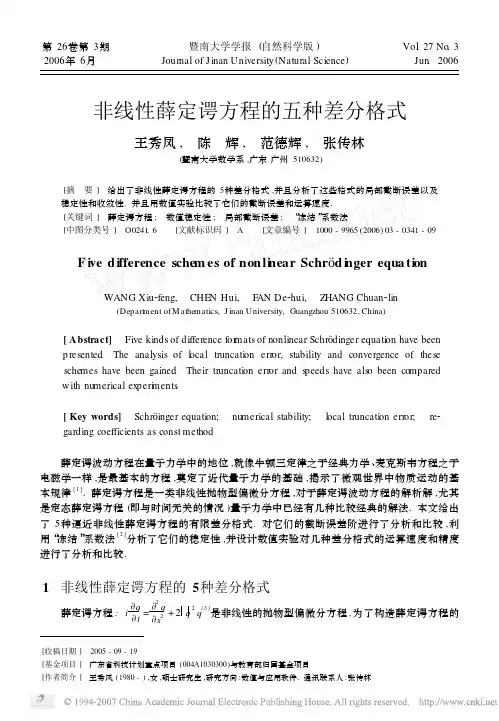
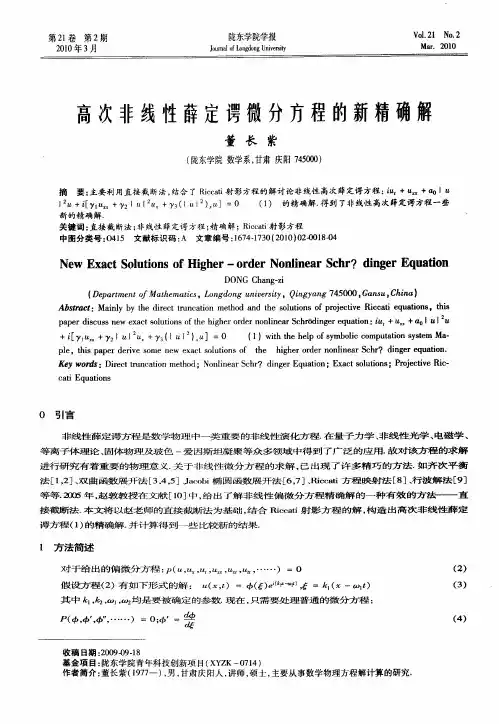
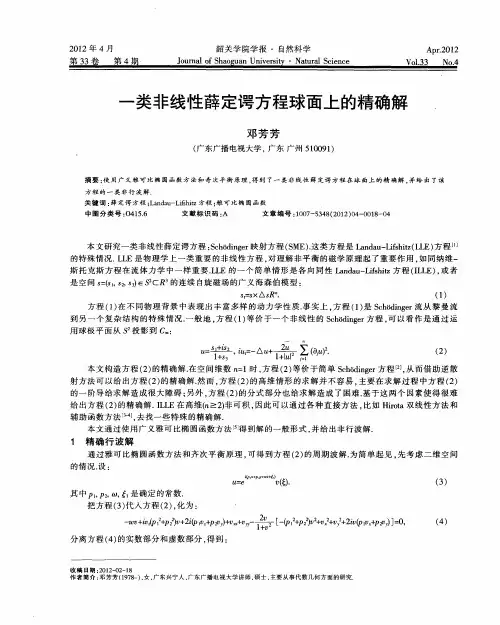
云南大学学报(自然科学版),2004,26(2):132~133CN53-1045/N ISSN0258-7971 Journal of Yunnan University*一类非线性薛定谔方程的孤子解刘良桂,李云德(云南大学物理系,云南昆明650091)摘要:研究了具有V(x,t)=f1(t)x+f2(t)x2形式的外部势的非线性薛定谔方程的单一孤立子解.结果表明:当孤立子的中心满足带有势V(x,t)的牛顿方程,孤立子的内部结构由/体固定0坐标系决定.孤立子的结构与f1(t)无关.若f2(t)与t无关,孤立子是固定的.原则上,若f2(t)剧烈变化,则孤立子将扩散.但数值计算表明,在一定条件下,孤立子还是经得起f2(t)的剧烈变化.关键词:玻色-爱因斯坦凝聚;非线性薛定谔方程;孤立子解;牛顿方程中图分类号:O413;O414文献标识码:A文章编号:0258-7971(2004)02-0132-02在诺贝尔奖设立百年之际,2001年诺贝尔奖授予了3位科学家,瑞典皇家科学院称颂他们得奖的原因是:/由于在碱性原子的稀薄气体中获得了玻色-爱因斯坦凝聚(BEC)和对这类凝聚体特性的早期基础研究0.一时间,这项世界上/最冷0的研究领域成了最热的话题.BEC的实验上的进展极大地推动了理论上努力预测这一宏观量子系统的性质.预测的起点往往是带有谐和捕获势的Gross-Pitaevskii方程.这是个非线性薛定谔方程,假设它对于零温度的稀薄气体(na3n1,这里n为平均密度,a为S波散射长度)也成立,这里量子和热涨落可以忽略.很多文献[1~4]已经讨论了该方程的解.但对于带有和时间有关的线性谐和势的非线性薛定谔方程的孤立子的情况却鲜有文章报道.本文讨论1+1维外部势具有二次形式V(x,t)=V1(x,t)+V2(x,t),V n(x,t)S f n(t)x n的非线性薛定谔方程的孤立子行为和结构,并导出相关结论.1方法和举例考虑非线性薛定谔方程i 9W9t=-12m92W9x2-g|W|2W+V(x,t)W,(1)其中W=W(x,t),m为/质量0,g>0,为一常数,V(x,t)为外部势.将W归一化,Q]-]|W(x,t)|2d x=1.外部势具有二次形式V(x,t)=V1(x,t)+V2(x,t),V n(x,t)S f n(t)x n,(2)其中f1(t),f2(t)均为t的函数,只是f2(t)还要满足下面将要讨论的条件.在缺少外部势的情况下,V(x,t)=0,方程(1)的单孤立子解为[5]W(x,t)=A0(x-M t)e i[m M x-(E0+m M2/2)t],(3)A0(x)=(J/2)1/2sech(J x),(4)E0=-J22m,J=12mg,(5)其中A0(x)决定了/自由0孤立子的形状,是与时间无关的方程-12m A0x x-gA30=E0A0(6)的束缚态解.运用Husimi变换[6],x c=x-N(t),(7)这里,x c为关于运动原点N(t)的坐标,后面,把N(t)看成孤立子的质心,将W(x,t)改写为W(x,t)=U(x c,t)e i m N#x c,(8)*收稿日期:2003-04-08基金项目:国家自然科学基金资助项目(10347011).作者简介:刘良桂(1976-),男,江西人,硕士,主要从事理论物理研究.其中N#=d N(t)/d t.可得W(x,t)=V(x c,t)ex p i m N#x c+i Q L(t c)d t c,(9)L(t)=12m N#2-V(N,t),(10)i V t=-12mV x c x c-g|V|2V+V2(x c,t)V.(11)(11)式与(1)式有2点不同:¹(1)式是对/实验室0系而言,而(11)式是对运动系而言,其原点定在x=N(t);º(11)式少了V1项,且关于x c的宇称是好量子数.由º可知(11)式具有束缚态解,且有Q]-]|V(x c,t c)|2x c d x c=0.束缚态结构由(11)式决定,且与N(t)无关.束缚态的质心位于x c=0,亦即x=N(t).x c坐标系是束缚态的/体固定0系.当g=0,f2(t)>0时,(11)式显然有束缚态解.当添加引力非线性项时,这些束缚态仍存在.非线性相互作用强烈影响着最低态,孤立子由此形成.若f2(t)<0,则V2(x,t)为一反转谐振子势;若g=0,则(11)式不允许束缚态存在.若g>0,即使f2(t)<0,仍存在束缚孤立子态.(Ñ)线性势V(x,t)=V1(x,t)=m A(t)x,(12)由V2=0,可知:A(x)=A0(x),E=E0.N(t)由m N=-A(t)决定.由N(t)可求出W(x,t).(Ò)谐振子模式V(x)=V2(x)=12m X2x2,(13)其中X为常数,式(18)变为-12mA x x-gA3+12m X2x2A=E A.(14)对非线性自相互作用,外部势相对强度可用(m X)1/2/J度量,这里J=12mg.系统的能量由下式给出E=Q]-]-12m(A x)2-12gA4+12m X2x2A2d x.(15)(Ó)反转谐振子模型V(x)=V2(x)=-12m X2x2,(16)W(x,t)可仿(Ò)求出.若非线性项-gA3不存在,则没有束缚态.设想一个定位在原点周围的函数A,该函数产生一有效的引力势-gA2.若对A 退定域,则系统能量增加.若进一步对A在原点之外退定域,则能量开始下降.若采用参量K来量度A的定域化度,则能量作为K的函数将有局域最小值,亦即意味着束缚态的存在.(Ô)受迫的谐振子模型V(x,t)=12m X2x2-m X2F(t)x,(17)这里m X2F(t)x是附加的微扰.由牛顿方程,可知N(t)=X Q]-]F(t c)sin[X(t-t c)]d t c.(18)可在式(18)右边加上类似N0cos X t的项.振幅函数A(x-N)与(Ò)中的相同.由(18)可求出W(x,t).无论F(t)变化多剧烈,该解仍保持有效. 2结语总而言之,对带有式(2)所示的与时间有关的二次势的非线性薛定谔方程所描写的孤立子而言,它的内部结构可从孤立子的质心运动分离出来.对质心而言,方程(1)可化简为牛顿方程m N##= -V N(N,t),对于孤立子的结构而言,方程(1)又可化简为式(11).孤立子结构与线性项V1(x,t)无关,因此孤立子经得起f1(t)的剧烈变化.原则上,若f2(t)剧烈变化,则孤立子将扩散.但数值计算表明,孤立子经得起f2(t)的剧烈变化.详细地讨论了V(x,t)为反转谐振子势(即f2(t)<0)时的孤立子行为.参考文献:[1]EDWAR DS M,DODD R J,CLA RK C W,et al.Proper-ties of a Bose-Einstein condensate in an anisotropic har-monic pot ential[J].Phys Rev A,1996,53(4):1950)1953.[2]BAYM G,PETHICK C.Ground-State properties of mag-netically trapped Bose-Condensed rubidium gas[J].PhysR ev L ett,1996,76(1):6)9.[3]HOL LAN D M,COOPER J.Ex pansion o f a Bose-Ein-stein condensate in a harmonic potential[J].Phys RevA,1996,53(4):1954)1957.[4]RU PRECHT P A,HOL LA ND M J,BU RNET T K,etal.Rea-l T ime Bose-Einstein condensationin a finite vo-lume w ith a discrete spectrum[J].Ibid,1995,51(3):4704)4708.(下转第138页)133第2期刘良桂等:一类非线性薛定谔方程的孤子解Preparation of matrix of quantum dots using AAO template by PLDCH EN Da-peng1,YANG Ru-i ming1,ZHANG Peng-x iang1,2,FANG Yan2,YANG Zhi2(1.Institute of Advanced M ater ials for Photoelectronics,K unming Universityof Science and T echnology,Kunming650051,China;2.L aboratory o f N ano-P hotoelectro nics of Beijing,Capital Nor mal University,Beijing10053,China;3.Department of Chemistry,Yunnan N ormal U niversity,Kunming650092,China)Abstract:M atrix of quantum dots is fabricated using anodic aluminum ox ide(AAO)tem plate and pulsed laser deposition(PLD).The cylindrical pore array structure of AAO serves as a template for the preparation of the quantum dots.T he morphology of the matrix of dots and AAO template are characterized by scanning elec-tron microscope,the luminescence spectra of the dots and target materials are recorded by a m icro-Ram an spec-trometer.The structure and photoluminescence of the dots are discussed,w hich demonstrates that one can make m atrix of quantum dots by this method.It is proofed that this method can fabricate the m atrix of a quan-tum dots of the other materials in the future.Key words:anodic alum inum ox ide template;nanostucture system;fluorescence materials;pulsed laser de-position;quantum dots********************************* (上接第133页)[5]刘良桂,李云德.一维Bose-Einstein凝聚中的孤波[J].云南大学学报(自然科学版),2003,25(4):332)334.[6]CH EN H H,L IU C S.No nlinear w ave and soliton prop-agation in media w ith arbitrary inhomog eneities[J].P hys Fluids,1978,21(3):377)380.Soliton solution of certain nonlinear SchrÊdinger equationLIU Liang-gui,LI Yun-de(Depar tment of Physics,Y unnan U niv ersity,Kunming650091,China)Abstract:The one-soliton solution of the nonlinear SchrÊdinger equation w ith an external potential of the form of V(x,t)=f1(t)x+f2(t)x2is ex amined.It is show n that,w hile the center of the soliton obeys Newton.s equation w ith the potential V(x,t),the internal structure of the soliton is determined by the NLSE of the/body-fix ed0coordinate system.The soliton structure is found to be independent of f1(t).In principle,the soliton can be diffused if f2(t)varies rapidly.Through num erical method,how ever,that the sol-i ton is ex tremely tenacious against rapid variations of f2(t).Key words:Bose-Einstein condensate;nonlinear SchrÊdinger equation;soliton solution;New ton.s equation 138云南大学学报(自然科学版)第26卷。
《(2+1)-维非线性薛定谔方程组的Lie对称、一维优化系统及约化》篇一标题:(2+1)-维非线性薛定谔方程组的Lie对称、一维优化系统及约化一、引言(2+1)-维非线性薛定谔方程组是物理学中重要的数学模型之一,其应用领域广泛,包括流体力学、非线性光学、等离子体物理等。
在求解此方程组的过程中,其复杂性常通过对称性和降维等手段来处理。
本文旨在探索其Lie对称性、一维优化系统及约化的应用,旨在寻求一种有效的方式来简化和求解这一复杂方程组。
二、(2+1)-维非线性薛定谔方程组的Lie对称性首先,我们分析(2+1)-维非线性薛定谔方程组的Lie对称性。
通过引入适当的对称变换,我们可以将原方程组转化为更易于处理的形式。
这一过程涉及到群论和对称性理论的应用,通过Lie 对称性的分析,我们可以得到方程组的守恒性质和对称性条件。
三、一维优化系统的建立在分析完Lie对称性后,我们进一步建立一维优化系统。
我们将原始的(2+1)-维非线性薛定谔方程组转化为一系列一维优化问题,每个问题都与原方程组的某个特定部分相关。
这种转化使我们能够使用传统的优化技术来解决原始的非线性问题。
在一维优化系统中,我们可以使用梯度下降法、最速下降法等算法来求解每个子问题。
四、约化方法的运用接着,我们介绍约化方法在(2+1)-维非线性薛定谔方程组中的应用。
约化方法主要通过将原问题分解为更简单的子问题来实现降维。
在本文中,我们将采用一些经典的约化方法,如变量分离法、群论方法等,来降低原问题的复杂性。
通过约化方法,我们可以将(2+1)-维问题转化为一系列一维或二维问题,从而更容易求解。
五、实验结果与讨论我们通过数值模拟和实验验证了上述方法的有效性。
首先,我们使用Lie对称性来简化(2+1)-维非线性薛定谔方程组,然后通过一维优化系统求解这些简化后的子问题。
最后,我们应用约化方法将原始问题转化为更简单的形式并求解。
实验结果表明,这些方法能够有效地简化(2+1)-维非线性薛定谔方程组并提高求解效率。
附录 1:翻译原文High-Order Solutions and GeneralizedDarbouxTransformations of Derivative Nonlinear Schr o dinger quationsBy Boling Guo, Liming Ling, and Q. P . LiuAbstractBy means of certain limit technique, two kinds of generalized Darboux transformations are constructed for the derivative nonlinear Schrodinger equations (DNLS). These transformations are shown to lead to two solution formulas for DNLS in terms of determinants. As applications, several different types of high-order solutions are calculated for this equation.1. IntroductionThe derivative nonlinear Schrodinger equations (DNLS) [1, 2]()20,t xx xiu u i u u++= (1)has many physical applications, especially in space plasma physics and nonlinear optics. It well describes small-amplitude nonlinear Alfv´en waves in a low-β plasma, propagating strictly parallel or at a small angle to the ambient magnetic field. It was shown that the DNLS also models large-amplitude magnetohydrodynamic (MHD) waves in a high-β plasma propagating at an arbitrary angle to the ambient magnetic field. In nonlinear optics, the modified nonlinear Schr¨odinger equations [3], which is gauge equivalent to DNLS, arisesin the theory of ultrashort femtosecond nonlinear pulses in optical fibres, when the spectralwidth of the pulses becomes comparable with the carrier frequency and the effect of self-steepening of the pulse should be taken into account.High-order solitons describe the interaction between N solitons of equal amplitude but having a particular chirp [4]. In the terminology of inverse scattering transformation (IST), they correspond to multiple-pole solitons. In the case of the Korteweg-de Vries equation (KdV), the poles must be simple, that is the reason why high-order nonsingular solitons do not exist. Indeed we could obtain multiple-pole solutions by Darboux transformation (DT), such as positon solutions [5]. The high-order solitons for nonlinear Schr¨odinger equations (NLS) had been studied by many authors [4, 6, 7]. To the best of our knowledge, the high-order solitons of DNLS have never been reported. The aim of this paper is to show that such solutions may be obtained by so-called generalized Darboux transformations (gDT).Recently, the rogue wave phenomenon [8], which “appears fr om nowhere and disappears without a trace,” has been a subject of extensive study. Those waves, also known as freak, monster, or giant waves, are characterized with large amplitudes and often appear on the sea surface. One of the possible ways to explain the rogue waves is the rogue wave solutions and modulation instability and there is a series of works done by Akhmediev’s group [9–11]. Different approaches have been proposed to construct the generalized rogue wave solutions of NLS, for example, the algebro-geometric method is adopted by Dubard et al. [12, 13], Ohta and Yang work in the framework of Hirota bilinear method [14] while the present authors use the gDT as a tool [15]. In the IST terminology, the high-order rogue wave corresponds to multiple-pole solution at the branch points of the spectrum in the non-vanishing background [16]. The first-order rogue wave for DNLS was obtained by Xu and coworkers recently [17]. However, the high-order rogue waves had never been studied. We will tackle this problem by constructing gDT.The DT [18, 19], which does not need to do the inverse spectral analysis, provides a direct way to solve the Lax pair equations algebraically. However, there is a defect that classical DT cannot be iterated at the same spectral parameter. This defect makes itimpossible to construct the high-order rogue wave solutions by DT directly. Thus, we must modify the DT method. In this work, we extend the DT by the limit technique, so that it may be iterated at the same spectral parameter. The modified transformation is referred as gDT. The inverse scattering method was used to study DNLS with vanishing background (VBC) and non-vanishing background (NVBC) [3, 20–23]. The N-bright soliton formula for DNLS was established by Nakamura and Chen by the Hirota bilinear method [24] and the DT for DNLS was constructed by Imai [25] and Steudel [26] (see also [17]). One key aim of this work is the construction of the gDT and based on it, the high-order soliton solutions and rogue waves are obtained. In addition to above two kinds of solutions, new N-solitons and high-order rational solutions are also found.The organization of this paper is as follows. In Section 2, we provide a rigorous proof for elementary DT of Kaup-Newell system (KN). Furthermore, based on the elementary DT, we construct for KN the binary DT, which is referred as the DT-II while the elementary DT is referred as DT-I. We also iterate these DT’s and work out the N -fold DT’s both for DT-I and DT-II, and consider two different kinds of reductions of the DT of the KN to the DNLS. In Section 3, the generalized DT-I and DT-II are constructed in detail by the limit technique. In Section 4, we consider the applications of the gDT and calculate various high-order solutions, which include high-order bright solitons with the VBC, and high-order rogue wave solutions. Final section concludes the paper and offers some discussions.2. Darboux transformation for DNLSLet us start with the following system —KN system [27]()()220,0,t xx xt xx xiu u i u v iv v i v u ++=-+-= (2)which may be written as the compatibility condition[],0,t x U V U V -+= (3)of the linear system or Lax pair,x U Φ=Φ (4a),t V Φ=Φ (4b)where23333324321221,,x iiiiU Q V Q Q Q Q σσσσζζζζζζζ=-+=-+-+-with3100,.010u Q v σ⎛⎫⎛⎫== ⎪ ⎪--⎝⎭⎝⎭These Equations (2) are reduced to the DNLS (1) for v u *=. For convenience, we introduce the following adjoint linear system for (4),,x U -ψ=ψ (5a).t V -ψ=ψ (5b)2.1. DT-IIn the following, we first consider the DT of the unreduced linear system (4). Generally speaking, DT is a special gauge transformation which keeps the form of Lax pair invariant. The explicit steps for constructing DT in 1+1 dimensional integrable system are as following: first, we consider the gauge transformation[]101,D D D ζ=+where 1D and 0D are unknown matrices which do not depend on 0ζ. Then imposing that D[1] is a DT we have[][][][][]()()[]()[]()1111,det 11det 1,x xD D U U D D Tr U U D +==-where U[1] represents the transformed U matrix. After some analysis, we find the following elementary DT (eDT) for (4):[]()1111111111110112,,,10TTD P P σσζζζσσ⎛⎫ΦΦ=+-== ⎪ΦΦ⎝⎭(6) where ()111,TϕφΦ=is a special solution for linear system (4) at 1ζζ=, and 11TσΦ is a special solution for adjoint linear system (5) at 1ζζ=-. Here we point out that this DT for DNLS was first derived by Imai [25]. With the help of the DT, Steudel [26] and Xu et al. [17] calculated various solutions for DNLS. Next, we give a rigorous proof that the above transformation does qualify as a DT.THEOREM 1. With 1 and D[1] defined above, [1] = D[1] solves[][][][][][]111,111x t U V Φ=ΦΦ=Φwhere[][][]311111,12111,12,x iU Q Q Q P σσσζσσζζ=-+=-and .[][][][][]2333343222111111.x iiiVQ Q Q Q σσσζζζζζ=-+-+-Namely, []1D qualifies as a Darboux matrix. Correspondingly, []11D - is a Darboux matrix for the adjoint Lax system. Proof : To begin with, we notice[]111111211.D I P ζσζζζζ-⎛⎫=+ ⎪+-⎝⎭What we need to do is to verify[][][][][]11,11111,x U D D D UD --=+ (7)[][][][][]11,11111.x V D D D VD --=+ (8)Firstweconsider(7). The residue for function()[][][][][]111,11111x F D D D UD U ζ--≡+-at 1ζζ=is()()()()()111111,1111Re 2x s F I P P I P U P ζζζσζσ⎡⎤=--+-⎣⎦()111111111120,TT I Pσζσσσ⎡⎤Φ=--Φ=⎢⎥ΦΦ⎣⎦where we used the relation [][][][]()11,1111x xD D D D --=-.Similarly, the residue offunction ()1F ζ at 1ζζ=- is.()()()()()111111,1111Re 2x s F I P P I P U P ζζζσζσ-⎡⎤=--+--⎣⎦()111111111120.T TxI P ζσσσσ⎡⎤Φ=-Φ=⎢⎥ΦΦ⎣⎦ Due to[][]321111,U Q σζζ=-+and[]11111,112,x Q Q P σσζσσ=- (9)the function ()[]11F D ζ is equal to zero at 0ζ=. Thus the function ()1F ζis analytic at 0ζ=. It is easy to see that ()10F ζ→ at ζ→∞. Therefore the equality (7) is valid. Now we turn to the time evolution part (8). We introduce a matrix[][]32143222111i i V Q V V σζζζζ=-+++, so that ()[][][][][]112,11111t F D D D VD V ζ--≡+-.Proceeding similarly as above, it is found that ()2F ζ is analytic at 1ζζ±, 0 and tends to zero as ζ→∞, thus ()20F ζ≡.In the following, we show [][]11V V =,Because of the compatibility condition[]()[]()11xttx D D Φ=Φ, we have[][][][]111,10.t x U V U V ⎡⎤-+=⎣⎦(10)Identifying terms of O(ζ ) in (10), we have[]32,0,V σ= (11)[][][]312,,121,x V V Q Q σ⎡⎤=+⎣⎦ (12)[]12,1,,x Q V V ⎡⎤=⎣⎦ (13)From (11), we have 20offV =, where 2off V denotes the off-diagonal part of 2V .Similarly, we have[][]133211,2offx iVi Q Q V σσ⎡⎤=-⎣⎦ (14)through (12). Substituting (14) into (13) and solving it yields []()2231.V iQ f t σ=-+Letting 10ζ=, one can readily obtain 22113V i Q σσσ=-. Therefore we have ()0f t =.Moreover,[][]31311x V Q iQ σ=-.Similar argument could show that []11D -does qualify as a Darboux matrix for the adjoint Lax system. Thus the proof is completed.Remark 1. In addition to (9) there is a different representation for []1Q[]()()()11113111121222,iQ I P Q I P I P σσσσσζ=--+- (15)which appeared in papers [17, 26]. We will use (9) rather than (15), since the former is more compact.To derive the N-fold DT for this elementary DT (6), which is referred as DT-I, we rewrite it as111111[1].D ϕζζφφζζϕ⎛⎫- ⎪ ⎪=⎪- ⎪⎝⎭Assuming N different solutions (),Ti i i ϕφΦ=of (4) at ()1,2,,i i N ζζ==are given, wemay havePROPOSITION 1. [17, 25, 26] The N-fold DT for DT-I can be represented as[][][]1110011,0N kNN k kN k k D D N D N D αζσσζβ-=⎛⎫=-=+⎪⎝⎭∑ (16) where i α are determined by the following equations2122101212222-1201222-1,21,2l l l i i i l i i l i i i i l l l i i i l i i l i i i i when N l when N l αϕαζφαζφαζϕζφαϕαζφαζϕαζφζϕ-+---⎧++++=-=+⎨++++=-=⎩ ;.1,2,,.i N = and ()(),,1,2,,.i i j j i j N βαϕφ=↔=The transformation between the fields is the following: (i) when 21N l =+[]()()[]()()()()det det ,,det det j j j j xB B u N v v N u A A ϕφϕφ⎡⎤↔⎡⎤⎢⎥=--=-+⎢⎥⎢⎥↔⎣⎦⎣⎦(17) where()()()()12122221222212,,,,,,,,,,,,,,,,,,,.T TT T TTN N l l l i i i i i i i i i i l l l i i i i i i i i i i A A A A B B B B A B ϕζφζϕζφζϕϕζφζϕζφζφ----====(ii) when 2N l =[]()()[]()()()()det det ,,det det j j j j xxD D u N u v N v C C ϕφϕφ⎡⎤↔⎡⎤⎢⎥=-=+⎢⎥⎢⎥↔⎣⎦⎣⎦(18)where()()()()121223222123222,,,,,,,,,,,,,,,,,,,.T TT TT TN N l l l i i i i i i i ii i l l l i i i i i iii i iC C C CD D D D C D ϕζφζφζϕζφϕζφζφζϕζϕ-----====2.2. DT-IIIn this section,we will showthat the so-called dressing-Backlund transformation [28, 29], denoted by DT-II in this paper, may be constructed from above DT-I. For convenience, we rewrite []1D and []11D - as following[][]111111122111111111,1.D D ϕφζζζζφϕφϕζζζζζζϕφ-⎛⎫⎛⎫- ⎪ ⎪⎪ ⎪==⎪ ⎪-- ⎪ ⎪⎝⎭⎝⎭(19) Suppose another solution ()111=,x ψψ for the adjoint system (5) at 1ζζ= is given, then[][]111111D ζξ-=ψ=ψis a new solution for adjoint system [][][]()1,1,1U V ψ at 1ζζ=.It is easy to see that []111Tσψ is a special solution for Lax pair [][][]()1,1,1U V Φ at1ζζ=-. Therefore, we could construct the second step DT D[2] by the seed solution[]111Tσψ . By direct calculations, removing the overall factor 221ζξ-, we have the DT-II[]223311111101,,02A A T I A ασσξζβζξζξ⎛⎫-=+-=Φψ ⎪-+⎝⎭(20) where111111111100,.00ξζαβζξ--⎛⎫⎛⎫=ψΦ=ψΦ ⎪ ⎪⎝⎭⎝⎭Furthermore, we have[]2213311111101,.02B BT I B βσσζξαζζζζ-⎛⎫-=+-=Φψ ⎪-+⎝⎭(21)The transformation between Q and new potential function Q is()33.x Q Q A A σσ=+- (22)Above discussion indicates that []1T , namely the DT-II, is indeed a two-fold DT for[]1D in the case of DNLS. We remark that for the two component DNLS the analogy of DT-II exists [30] while the corresponding DT-I has not been constructed.In what follows, we consider the iteration of the DT-II. Assume that we have N distinct solutions ()(),Ti i i i μϕφΦ=of (4) at i ζμ= and N distinct solutions ()(),i i i i x νψψ= of (5) at i ζν=. Similar to DT-I, we work with DT-II and have the following proposition PROPOSITION 2. The N-fold DT for the DT-II could be written as the following form[][][]33111,N i i N i ii C C T T N T N T I σσζνζν=⎛⎫=-=+- ⎪-+⎝⎭∑ (23) and[][][]111133111.Ni i Ni ii D D TT N T N T I σσζμζμ----=⎛⎫=-=+- ⎪-+⎝⎭∑ (24)Proof : We calculate the residues for both sides of (23)()()333131113331313311Re ,Re .iiN N N ii N i N i i N N N i i N i N i i s T A A A A I A I s T A A A A I A I ζνζνσσσσννννννννσσσσσσνννννννν==-⎛⎫⎛⎫=+-+- ⎪⎪-+-+⎝⎭⎝⎭⎛⎫⎛⎫=-+-+- ⎪⎪---+---+⎝⎭⎝⎭Because of ()()33Re Re iiN N s T s T ζνζνσσ==-=-, Equation (23) is valid. Similarly,(24) can be proved.The N-fold DT-II N T allows us to find the transformations between the fields ,u v and[][],u N v N , which are given belowTHEOREM 2. The N-fold DT-II N T induces the following transformations for the fields[][]11det det 2,2,det det x xM N u N u v N v M N ⎛⎫⎛⎫=-=+ ⎪ ⎪⎝⎭⎝⎭ (25) where()()33,,,,i ji jij ij ij N NN Nj ij ii j i j ij j i j i M M N N M N σμνμνσμνμν⨯⨯ψΦψΦ===-+-⎡⎤ψΦψΦ=-+⎢⎥+-⎢⎥⎣⎦1112111112112122222122221112121212,.00N N N N N N NNN N N NNN N NM M M N N N x M M M N N N x M N M M M N N N x ψψψφφφϕϕϕ⎛⎫⎛⎫ ⎪ ⎪ ⎪⎪⎪ ⎪== ⎪ ⎪ ⎪ ⎪ ⎪ ⎪⎝⎭⎝⎭Proof : Since N T (23) is the N-fold DT of (4), we have[],.N x N N T T U U N T +=It follows that[][]331.Ni i x j Q N Q C C σσ==+-∑Thus, we need to calculate the explicit forms for i C . Proposition 2 gives()Re ii N C s T ζμ==, and implies that 'i C s are the matrices of rank one. Thus we mayassume i ii C x y =. Similarly we may set i i i D ων=.On the one hand, because of 1N N T T I -=, we have10,ll Ny T ζν-== (26)where the fact that the residue of 1N N T T - at l ζν= equals to zero is taken account of. On the other hand, we have10.l NlT ζν-=ψ=Noticing that the rank of 1N l T ζν-=is 1, we may obtain.l l y =ψNow substituting l y into (26) leads to()3310,1,2,,.N i i l i i ll i l il i x x l N σσμνμν=⎛ψΦψΦ⎫Φ+-== ⎪-+⎝⎭∑ (27)Solving (27) gives us[][]112121112122,,,,,,,,,,,,,,,.N N N N x x x Mx x x N ϕϕϕφφφ--⎡⎤=⎣⎦⎡⎤=⎣⎦where subscripts 1 and 2 stand the first and second rows, respectively. Finally, the relations between the fields can be represented as[][][][]121112121112det 2,,,2,det det 2,,,2.det N xN N xN M u N u M u M x x N v N v N v N x ψψϕϕϕψφφφ--⎡⎤⎡⎤⎢⎥⎢⎥⎛⎫⎢⎥⎢⎥=+=- ⎪⎢⎥⎢⎥⎝⎭⎢⎥⎢⎥⎢⎥⎣⎦⎣⎦⎡⎤⎡⎤⎢⎥⎢⎥⎛⎫⎢⎥⎢⎥=-=+ ⎪⎢⎥⎢⎥⎝⎭⎢⎥⎢⎥⎢⎥⎣⎦⎣⎦This completes the proof.2.3. ReductionsSo far we have been working with the DTs for the general Lax problem (4) and certain solution formulae have been given for the system (2). However our main task is to construct solutions for DNLS (1), therefore we have to study reduction problem. It is easy to see that two reductions v u *= and v u *=- are simply related [26], so we mayconsider either of them. For the DT-I, let us assume v u *= or †Q Q =-, where †denotes the complex conjugation and matrix transpose. To implement the reduction, we need to choose the seed solutions properly. Indeed, assuming111,i ζϕφ*∈=, (28)then []1Q , defined by (9), satisfies the reduction relation [][]†11Q Q =-. The DT (6) with the reduction condition (28) may be employed to construct bright or dark solitons of DNLS with the nonvanishing background.Let us now turn to the reduction of the DT-II. Assuming †Q Q =- and()()111111,,,,x ξζψϕφ***== (29)(22) yields †Q Q =-.To iterate the reduced DT-I and DT-II, we must verify that they keep the reduction conditions (28) and (29). The latter merely depends on the symmetry of Equation (4), thus it holds automatically. For the former (28) we claim thatProposition 3. Both DT []1D and []1T keep the reduction condition (28) invariant. Proof : Direct calculations.Due to above analysis, both DT-I and DT-II may be reduced to find solutions for DNLS. However, the DT-I under (28) is conveniently used to construct the N-dark or bright soliton solutions of DNLS with NVBC, while DT-II with (29) may be properly adopted to represent the N-bright solitons and N-breathers of DNLS.3. Generalized Darboux transformationsIn t his section, we construct the corresponding gDT’s associated with []1D and []1T . We will follow the approach proposed for the nonlinear Schr¨odinger equations in [15]. Indeed, while both DT-I and DT-II considered above are degenerate at 1ζζ= in the sense that [][]1111110D T ζζζζ==Φ=Φ=, we may work with[][]()111101lim,D ζζεεε=+→ΦΦ=or[][]()111101l i m,T ζζεεε=+→ΦΦ= which serves the seed solution for doing the next step transformation.3.1. gDT-ITo construct the gDT associated with DT-I, we assume that n solutions (),Ti i ϕφ aregiven for the Lax pair at ()1,2,,i i n ζζ==. First, we have the elementary DT[]11011111.D ϕζζφφζζϕ⎛⎫- ⎪ ⎪=⎪- ⎪⎝⎭As observed earlier, by virtue of the limit process, we find that[][][]()()1011111110111lim D ζζεεσϕζεϕφζεεφ=→+⎛⎫+⎛⎫= ⎪ ⎪ ⎪+⎝⎭⎝⎭[]()()()()11011111111d D d ζζζζϕζϕζσφζφζζ==⎛⎫⎛⎫=+ ⎪ ⎪⎝⎭⎝⎭is a nontrivial solution for Lax pair (4) with []1u u = and []1v v = at 1ζζ=, which may lead to the next step transformation[][][][][]111111111111.D ϕζζφφζζϕ⎛⎫- ⎪⎪=⎪ ⎪- ⎪⎝⎭This process may be continued and we have the following theorem THEOREM 3. Let(),Ti i ϕφbe the solutions of Lax pair at ()1,2,,i i n ζζ== andassume that DT-I possesses mi order zeros at 1ζζ=. Then we have the following gDT-I: [][][][][][]111110111,nm m N n n nD D D D DD D--= (30) where[][][][][]11111,,j i i j ni j i i j i ii j i N m D ϕζζφφζζϕ---=-⎛⎫- ⎪⎪== ⎪ ⎪- ⎪⎝⎭∑ and[][][][]1011101,,!i j j j l i i i i l j i i i i i d l d ζζϕϕϕϕφφζφφ-----==⎛⎫⎛⎫Ω⎛⎫⎛⎫== ⎪ ⎪ ⎪ ⎪ ⎪ ⎪⎝⎭⎝⎭⎝⎭⎝⎭∑ (31) and[][][][][][]11201011,1;,,0.k i i k i j m k k l i i i k i i lif M M M M M D if δζζσδδ--==⎧=⎪Ω==⎨=⎪∑⎩∑Proof : To construct the gDT-I, we start with the elementary DT[]11011111.D ϕζζφφζζϕ⎛⎫- ⎪ ⎪= ⎪- ⎪⎝⎭By means of the nontrivial solutions [][]()111,1ϕφ, we may do the next step oftransformation []11D . Taking account of the given seeds (),Ti i ϕφ, we perform thefollowing limit[][][][][][][][]()()11101101110lim ,i j m j i i i ii i jj i i i D D D D D D ζζεεϕϕζεφζεεφ--=+→⎡⎤⎛⎫+⎛⎫⎣⎦= ⎪ ⎪ ⎪+⎝⎭⎝⎭which yields the formulae presented in above theorem. This completes the proof.To have a compact determinant representation for the gDT-I, we may take the limit directly on the N-fold DT-I (16). It follows from (17) and (18) that the transformations between the fields are: (i)When 21N l =+[]()()[]()()()()det det ,,det det j j j j xxB B u N v v N u A A ϕφϕφ⎡⎤↔⎡⎤⎢⎥=--=-+⎢⎥⎢⎥↔⎣⎦⎣⎦(32)where()()1111111111,,,,,,,,,1!1!n n m m T TT TT Tn n n m m n d d d d A A A A A A A d m d d m d ζζζζ----⎛⎫= ⎪ ⎪--⎝⎭()()1111111111,,,,,,,,,1!1!n n m m T TTT TTnn n m m n d d d d B B B B B B B d m d d m d ζζζζ----⎛⎫= ⎪ ⎪--⎝⎭and ,i i A B are the same as (17). (ii) When2N l =[]()()[]()()()()d e t d e t ,,det det j j j j xxD D u N u v N v C C ϕφϕφ⎡⎤↔⎡⎤⎢⎥=-=+⎢⎥⎢⎥↔⎣⎦⎣⎦(33)where()()1111111111,,,,,,,,,1!1!n n m m T TTT TTnn n m m n d d d d C C C C C C C d m d d m d ζζζζ----⎛⎫= ⎪ ⎪--⎝⎭()()1111111111,,,,,,,,,1!1!n n m m T T TT TT nn n m m n d d d d D D D D D D D d m d d m d ζζζζ----⎛⎫= ⎪ ⎪--⎝⎭and ,i i C D are the same as (18).Thus, we complete the construction of gDT-I for (4), which could be considered as a generalization for DT studied in [17, 25, 26].3.2. gDT-IIIn this subsection, we consider the generalization for DT-II. To this end, we assume that n solutions ()(),Ti i i ζμϕφΦ== are given for the Lax pair (4) at i μμ= and n solutions()(),i i i x ζνψψ== are given for the adjoint Lax pair (5) at ()1,,i i n μμ==THEOREM 4. Let i Φ be the solutions of Lax pair (4) at i ζμ= and i ψ be the solutions of adjoint Lax pair (5) at ()1,,i i n ζν==,1,rii mN ==∑assume that DT-II possesses mi order zeros at i ζμ=± and inverse of DT-II possessesi m order zeros at i ζν=±. Then we have the following gDT-II[][][][]()[]()()[]()1111001111111011011,i i m m N n nm m NnnT T TT T TT T T T ---------== (34)where[][][][]()[][]13333,,jjjjj ji i i i i i i ii iA AB B T I T I σσσσζνζνζμζμ-=+-=+--+-+[][][][][][][][][][]22220,200,20j j j j iiii i i j i j j j jiiiii i j i A B ανμββμνα⎛⎫-=Φψ⎪ ⎪⎝⎭⎛⎫-=Φψ ⎪ ⎪⎝⎭[]()[][][]()[][]1100,,00j j j j j j iiii i i i i i i νμαβμν--⎛⎫⎛⎫=ψΦ=ψΦ⎪ ⎪⎝⎭⎝⎭and[]()[][][][]10101011,!,ij i j ljj i iij li j m l i i ld j l d M M M M μμδμ--==--=ΩΦ=Φ-Ω=∑∑∑[]()0,!ij ljj l i i j l i d d j l ννμ--==Λψ=ψ-∑[][][][]1101011,ji j m l iilN N N N δ--=Λ=∑∑[][][][]2233221,2;2,1;,,0.ij i i ij j j j i i i ii i ij ji i if A A M if T if ζμδμνμσσδμνδ=⎧=⎪-⎪⎪+-⎪==⎨-⎪⎪=⎪⎪⎩[][][][]()22332211,2;2,1;,0.i ji i ij j j j i i i i i i ij ji i if B B N if T if ζνδνμνσσδνμδ-=⎧=⎪-⎪⎪+-⎪==⎨-⎪⎪=⎪⎪⎩Proof : Noting that the DT-II is given (20) and using the limit technique, we could obtain special solutions for new Lax pair (4) [][][]()1,1,1U V Φ at i ζμ= and adjoint Lax pair (5) [][][]()1,1,1U V ψ at i ζν=, that is,[][]()[]()[]()[][]()1111110111101111110011111011111110lim,lim,T dT S d T d T R d ζμδμμδζμζνδννδζνμδμδμνδνδν=+=→=-=+-=→=Φ+Φ==Φ+Φψ+ψ==ψ+ψwhere1131311313112222111122,.A A B B S R μσσνσσμννμ+-+-==-- Therefore, we may continue to construct for the new system the DT-II T [2][][][][]()[][]111111131331311111111,.A B A B T I T I σσσσζνζνζμζμ-=+-=+--+-+Generally, taking account of the given seeds i Φ and i ψ, we perform the following limit[][][][][]()()[]()[]()[]()[]()[]()11001101111110011lim,lim ,i i i i m j i i j i i i j m j i iji i i jT T T T T T T T ζμδδζνδδμδδνδδ--=+→------=+→Φ=Φ+⎛⎫⎪⎝⎭ψ=ψ+ and mathematical induction leads to gDT-II (34). This completes the proof. Due to above proposition, the transformations between the fields are[][]()112102,i m n j i x i j u N u A -==⎡⎤=+⎣⎦∑∑ (35)[][]()121102,.i m n j i x i j v N v A -==⎡⎤=-⎣⎦∑∑ (36)As before, the formulas (35) and (36) could be rewritten in terms of determinants, that is,[]()()[]()()11det det 2,2.det det x xP Q u N u v N v P Q ⎛⎫⎛⎫=-=+ ⎪ ⎪ ⎪ ⎪⎝⎭⎝⎭ (37) where[][][][][][][][][][][][][][][][][][]11121111121212222212221121212,,0r rr r r r rr r r r rr rP P P P P P P P P P P P P P p P P P P P ψψψϕϕϕ⎛⎫⎪⎛⎫⎪ ⎪ ⎪ ⎪==⎪⎪ ⎪ ⎪ ⎪ ⎪⎝⎭⎪⎝⎭with()()[][]()1111,1,,,1!1,,,1!,i i jj j ik lTm i i i i m i m j j j im j ijij klm m m m P P ννμμψψψψννϕϕϕϕμμ--=--=⎛⎫∂∂= ⎪ ⎪∂-∂⎝⎭⎛⎫∂∂⎪= ⎪∂-∂⎝⎭=[]()()()()()()2311,11!1!i jk l ij i j i j klk l P k l μμνννσμνμνμμνμν+---==ψΦψΦ⎛⎫∂=- ⎪--∂∂+-⎝⎭and[][][][][][][][][][][][][][][][][][]11121111121212222212221121212,,0r rr r r r rr r r r rr rQ Q Q x Q Q Q Q Q Q x Q Q Q Q Q Q Q Q x Q Q Q φφφ⎛⎫ ⎪⎛⎫⎪ ⎪ ⎪ ⎪==⎪⎪ ⎪ ⎪ ⎪ ⎪⎝⎭⎪⎝⎭with()()11111,,,1!1,,,1!i i ij j jTm i i i i m i m j j j im j x x x x m m ννμμννφφφφμμ--=--=⎛⎫∂∂= ⎪⎪∂-∂⎝⎭⎛⎫∂∂⎪= ⎪∂-∂⎝⎭[][](),,k lijijklm m Q Q =[]()()()()()()2311,11!1!i jk l ij i j i j klk l Q k l μμνννσμνμνμμνμν+---==ψΦψΦ⎛⎫∂=-+ ⎪--∂∂+-⎝⎭According to above theorems, it is not difficult to see that the reductions (28) and (29) are still valid for gDT-I and gDT-II. For the gDT-II, to reduce system (4) to DNLS, we must set i i μν*=.4. High-order solutions for DNLSIntegrable nonlinear partial differential equations are well known for their richness of solutions. To construct those solutions, a number of approaches have been proposed including I ST, Dressing method, Hirota’s bilinear theory and Darboux (B¨acklund) method, etc.While classical DT is known to be a convenient tool to construct N-soliton solutions, it may not be directly used to obtain the high-order solutions, which correspond to multiple poles of the reflection coefficient in the IST terminology (see [6] and the references there). We will show in this section that the gDT derived above can be applied to obtain various solutions for DNLS. Indeed, apart from the high-order solutions, a kind of new N-soliton solutions will also appear. In Section 4.1, we consider the solutions with the VBC. In particular, N-rational solitons, high-order rational solitons and high-order solitons are worked out. In Section 4.2, we construct the high-order solutions with NVBC which include the high-order rational solutions with NVBC and high-order rogue wave solutions.4.1. Solutions with VBCApplying DT-I to vacuum, we may obtain three kinds of solutions, namely plane wave solutions, N-phase solutions (periodic solutions) and N-soliton solutions (see [17]). Additionally, if we take limit of the soliton solutions, we can find rational solutions [17, 27].In this section, we consider the N-rational solutions first. As we pointed out, the rational solitons are the limit cases to the soliton solutions. The different behaviours of the high-order rational solitons and high-order solitons are indicated.In the first two cases, gDT-I will be used, while for the case 3, it is more convenient to use the gDT-II since the spectral parameters need to be conjugated with each other.Case 1: N-rational solutionsWe first consider the rational solitons and their higher order analogies. For the seedsolution 0u =, the special solution for Lax pair (4) with the reduction u ν*= is()()222222,i x t ci x t c e e ζζζζϕφ-----++++⎛⎫⎛⎫ ⎪= ⎪ ⎪⎝⎭⎝⎭(38)where c is a complex constant, which will be taken as a polynomial function of ζ so that the high-order solutions with free parameters may be constructed. To obtain the N-rational solitons, we introduce vectors()()2222221,,,,,,,,,,N N N N y z ϕζφζϕζϕϕζφζϕζφ---==and define the matrices()()()()11111111,,N N N N y z y z Y Z y z y z ⎛⎫⎛⎫⎪ ⎪ ⎪ ⎪⎪ ⎪== ⎪ ⎪ ⎪ ⎪⎪ ⎪⎝⎭⎝⎭where,i i i c c y y ζζ=== and ,i ii c c z z ζζ===, the superscript (1) represents the first-order。
CHAPTERIVNUMERICALSOLUTIONSTOTHENONLINEARSCHRÖDINGEREQUATION
4.1IntroductionIngeneral,analyticalsolutionstothefullMaxwellwaveequationforanonlinearopticalsystemdonotexist.Evennumericalsolutionstothewaveequationareextremelydifficulttoimplementduetothedimensionalityoftheproblem.Thevectorformofthewaveequationisafour-dimensional(threespatial,onetemporal),second-orderpartialdifferentialequation.Thus,approximationsbasedonpropagationconditionsandexperimentalresultsareneededinordertosolveanapproximatescalarformofthewaveequation,i.e.thenonlinearSchrödingerequation.However,theapproximationslistedinthepreviouschapterdolimitthegeneralityandvalidityofthesolutions.Forexample,theconditionextremenonlinearity,asforthecaseinsupercontinuumgeneration,isapropagationregimewhereslowlyvaryingenvelopeapproximationmaybeviolated.ThepurposeofthischapteristoprovideanintroductiontoaverypowerfulmethodinnumericallysolvingtheNLSE,knownasthesplit-stepFouriermethod(SSFM)[15].ThechapterwillbeginwithalistpointingtheadvantagesoftheSSFMcomparedtofinite-differencemethods.Then,theSSFMthesymmetricSSFMwillbeintroduced.ThechapterwillthendetailtheinclusionoftheRamaneffectinthenumericalsolution.
4.2WhyusetheSplit-StepFourierMethod?TheSSFMisthetechniqueofchoiceforsolvingtheNLSEduetoitseasyimplementationandspeedcomparedtoothermethods,notablytime-domainfinite-differencemethods[73].ThefinitedifferencemethodsolvestheMaxwell’swaveequationexplicitlyinthetime-domainundertheassumptionoftheparaxialapproximation.TheSSFMfallsunderthecategoryofpseudospectralmethods,whichtypicallyarefasterbyanorderofmagnitudecomparedtofinitedifferencemethods[74].Themajordifferencebetweentime-domaintechniquesandtheSSFMisthattheformaldealswithallelectromagneticcomponentswithouteliminatingthecarrierfrequency.Asshowninthepreviouschapter,thecarrierfrequencyisdroppedfromthederivationoftheNLSE.Thus,finitedifferencemethodscanaccountforforwardandbackwardpropagatingwaves,whiletheNLSEderivedfortheSSFMcannot.Sincethecarrierfrequencyisnotdroppedintheformoftheelectricfield,finite-differencemethodscanaccuratelydescribepulsepropagationofnearlysingle-cyclepulses.WhilethefinitedifferencemethodmaybemoreaccuratethantheSSFM,itisonlyatthecostofmorecomputationtime.Inpractice,themethodchosentosolvetheNLSEdependsontheproblemathand.Forpulsepropagationfortelecommunicationapplications(~100pspulsesthrough80kmoffiberwithdispersionandSPM)theSSFMworksextremelywellandproducesresultsthatareinexcellentagreementwiththeexperiments[75,76].However,theSSFMwouldnotworkformodelingfiberBragggratingswherethereexistsaforwardandbackwardpropagatingwave.ThisthesisdemonstratesthattheSSFMalsoworksefficientlyandaccuratelyfordescribingpulsepropagationinmicrostructurefiber.
4.3TheSplit-StepFourierMethodThemathematicaltermsduedispersionandnonlinearityareseparateanddecoupledintheNLSE.ItisthisfactthatallowstheuseoftheSSFMforsolvingtheNLSE.BylookingatNLSE,theoperatorsˆDandˆNcanbewrittentocorrespondtothedispersive(andabsorptive)andnonlineartermsrespectively(ignoringtheRamaneffect),
112ˆ=22mmmmm
m
iDt−−=α∂−−β∂¦(4.1)
and()22
0
2ˆ(,)(,)(,)(,)i
NiEztEztEztEztt§·∂=γ+¨¸ω∂©¹(4.2)
whereE(z,t)isthecomplexfieldenvelopeatstepzandtimet.TheNLSEthencanbewrittenintheoperatorformas
(,)ˆˆ()(,).
Ezt
DNEzt
z
∂=+
∂(4.3)where()ˆˆ(,)exp((1),),EjhthDNEjhtªº=+−¬¼(4.4)
isasolutiontothedifferentialequationatstepz=jh(jisaninteger).NotethattheˆNoperatormultipliesthefieldsolutionandisafunctionofthesolutionE(z,t).TheˆD
operatorisadifferentialoperatorexpressedintermsoftimederivativesthatoperateonE(z,t).Toreducethecomputationaltime,theoperationofˆDisperformedinthefrequencydomain;thistransformsthederivativesinthetimedomaintoamultiplicationinthefrequencydomain.AftertakingtheFouriertransformofˆDthemultiplicativeoperatorinthefrequencydomainisobtained,
111122ˆˆ(){}().2222mmmmmmmmm
mm
iiDiDi
t
−−
−−==
½α∂α
ω≡=−−β=−−βω®¾
∂¯¿
¦¦))
(4.5)TheSSFMisaniterativeprocessthatdeterminesthefieldsolutionforspatialstepsofh.Thisisperformedstep-by-stepfortheentirelengthofthefiber.TheprocedureduringonestepisillustratedinFigure4.1.AdielectricmediumoflengthLisbrokenintosL=L/hstepsoflengthh.ThefieldpropagationsolutionE(jh,t)perspatialstephatthestepjh(j=1,2,….sL)fortheentirelengthoffiberusingrelation
()(){}{}1ˆˆ(,)exp()exp((1),),EjhthDiFhNEjht−≈ω−)
(4.6)